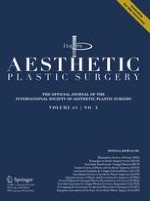Erschienen in:

26.01.2017 | Original Article
Comparative Study Using Autologous Fat Grafts Plus Platelet-Rich Plasma With or Without Fractional CO2 Laser Resurfacing in Treatment of Acne Scars: Analysis of Outcomes and Satisfaction With FACE-Q
verfasst von:
S. Tenna, A. Cogliandro, M. Barone, Vincenzo Panasiti, M. Tirindelli, Carolina Nobile, Paolo Persichetti
Erschienen in:
Aesthetic Plastic Surgery
|
Ausgabe 3/2017
Einloggen, um Zugang zu erhalten
Abstract
Background
A multitude of options are traditionally used for the treatment of acne scars; however, newer treatment modalities are emerging to decrease the propensity for post-inflammatory hyperpigmentation and upregulate new collagen production. The aim of this study was to evaluate the efficacy of nanofat and platelet-rich plasma (PRP) infiltration alone and combined with fractional CO2 laser resurfacing to improve atrophic scars of the face.
Methods
From March 2014 to June 2015, 30 patients with atrophic acne scars on the cheeks were selected for this study. Patients were evaluated pre- and postoperatively by physical examination, photographs and ultrasound with a 22-MHz probe to measure subcutaneous tissue thickness. All patients were treated with infiltration of nanofat plus PRP. The production of PRP was achieved using the RegenLab THT tube® method. In 15 randomly chosen patients, a fractional CO2 laser resurfacing at 15 W was also performed right after the infiltration. An Italian version of the FACE-Q postoperative module was administered to analyze each patient’s satisfaction and aesthetic perception of the result.
Results
The average preoperative thickness of subcutaneous tissue of patients from group A was 0.532 cm, while the average preoperative thickness of subcutaneous tissue of patients from group B was 0.737 cm. The average postoperative thickness of subcutaneous tissue was 1.201 cm in group A and 1.367 cm in group B. The improvement of thickness of subcutaneous tissue was 0.668 cm in group A and 0.63 cm in group B. We applied a t test on unpaired data, comparing the difference in thickness obtained with the treatment in both group A and in group B, with a p value =0.7289 (not significant). All patients in both groups had a treatment benefit, confirmed with FACE-Q postoperative module, but without a significant difference between the two groups.
Conclusions
Subcutaneous infiltration with nanofat and PRP seems to be effective to improve atrophic scars, either alone or combined with fractional CO2 laser resurfacing. The FACE-Q module confirmed the impact of treatment of facial acne scars in social life and relationships.
Level of Evidence III
This journal requires that authors assign a level of evidence to each article. For a full description of these Evidence-Based Medicine ratings, please refer to the Table of Contents or the online Instructions to Authors
www.springer.com/00266.











